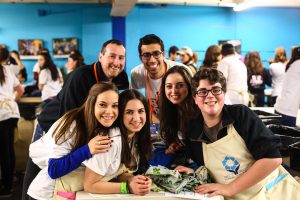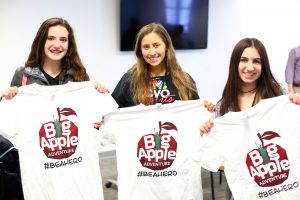A new program is knocking down hurdles to Jewish teen engagement.
No matter your organization, mission or audience, there are hurdles to teen engagement, and success in today’s world requires new models of engagement to confront obstacles facing teens, including overextended schedules, academic pressure, the feeling of not fitting into existing programs, and a lack of relevance of the Jewish community and its teachings.
We know that effective Jewish programming needs to engage teens through their interests and speak to their passions. Teen program providers should recognize the obstacles to participation while offering a range of ways for teens to connect and stay connected within the Jewish community.
With this in mind, a new platform has been conceived by the Atlanta Jewish Teen Initiative, the ninth city in the Jewish Teen Education & Engagement Funder Collaborative. This bold experiment targets Jewish teens not fully engaged in Jewish life through a new program, JumpSpark, which offers interest-based intensives for Jewish teens during school breaks.
Teens have diverse interests and talents, so there cannot be a one-size-fits-all approach. The goal and methodology of JumpSpark addresses the gap between the pursuit of areas of interest and Jewish involvement.
The innovation in our platform is adaptable and can be replicated in any community across the country with four guiding principles:
- Don’t make teens choose.
We know students’ lives are complex and busy. Successful teen models will find topics that students are already interested in and meet them there. Jewish values are part of our everyday lives, and, as educators, it’s our role to help build those bridges for our teens.
As an example, our pilot intensive, JumpSpark Sports, will run from Jan. 2 to 5, the final week of the holiday break for many Atlanta school districts, and will engage students through a behind-the-scenes look at the sports industry.
This intensive program offers stadium tours, speakers, hands-on skill-building clinics and exposure to the business of sports. The intensive will couch those experiences in the language of Jewish wisdom and learning.
A trip to the College Football Hall of Fame will culminate in a discussion of Jewish models of heroes and how those values translate to modern sports heroes in a partnership with Beit Hatfutsot. A clinic with associate director of referee development for the NBA, Scott Bolnick, will be a lesson in tochecha, the Jewish laws of giving rebuke, with a larger focus on giving and receiving feedback.
- Help teens build their résumé of life.
Teens prioritize activities that they feel are valuable, engaging and exceptional and are more likely to participate in activities that they think will help them get into college or assist their career path.
Every JumpSpark intensive will bring together a small cohort of teens who will use the unique features and people of Atlanta to learn, work and give back to the community together. Our participants will increase their knowledge, develop skills, clarify values, build Jewish identity and develop the capacity to contribute to the Jewish community and the world at large.
- Partnership, partnership, partnership.
From its inception, the Atlanta Jewish Teen Initiative is rooted in collaboration. We cultivate partnerships with community professionals, educational institutions and other organizations, enabling us to use Atlanta as our classroom. However, AJTI is also the first programmatic partnership among the Marcus JCC, the Federation of Greater Atlanta and the Atlanta Rabbinical Association.
- Meet teens where they are and show them how their interests are meaningful using a Jewish lens.
Programs need to be offered during a time that works for students today. The Atlanta Jewish Teen Initiative’s educational vision is to engage Jewish teens in growth opportunities through exceptional educational, community-building programs.
Motivated by the words of Isaac Luria, the 16th century master of Kabbalah, who said, “There is no sphere of existence that is not full of holy sparks,” the Atlanta Jewish Teen Initiative will guide teens to uncover meaning in their areas of interest and empower them to lift those “sparks” through engagement with Jewish wisdom, texts and values in accessible and relevant ways.
JumpSpark was inspired by a Brandeis University study, “Engaging Jewish Teens: A Study of New York Teens, Parents and Practitioners,” which said: “Virtually every teen is engaged in at least one extracurricular activity and over half hold at least one leadership position. Sports appear at the top of the list and Jewish activities at the bottom. The main reasons teens choose these activities are that they are fun and give them opportunities to learn new things and develop skills.”
Students should not have to choose between extracurriculars and Jewish involvement. Our goal, thus, is to ignite a spark in teens and to lower at least one hurdle to engagement. In the months ahead, JumpSpark will offer intensives on culinary arts, music, esports, dramatic arts, fashion, and writing and publishing, just to name a few. We are planning a weeklong program discussing civil rights in collaboration with the National Center for Civil and Human Rights and Etgar 36.
When electricity jumps across a gap, a spark, called a jump-spark, is produced. This is the inspiration behind our program name and reflects our mission to help ignite sparks within individual teens and within the Jewish teen community.
To learn more about our teen program and to join our mailing list, visit JumpSparkATL.org. Registration for JumpSpark programs is open. Contact [email protected] for more information.
Hope Chernak is the executive director of the Atlanta Jewish Teen Initiative. Kelly Cohen is the education director of the Atlanta Jewish Teen Initiative.


 We’re proud to report that the trip was far more successful than we ever could have imagined. In the blog written by the teens themselves on the trip, many spoke of the “meaning” and “connection” the trip had engendered. Many of the parents expressed the same sentiment, especially after being able to watch the teens in action in New York, during Facebook Live events. As one parent remarked, “I feel so fortunate that my child received this opportunity to embrace and love her Jewish heritage.”
We’re proud to report that the trip was far more successful than we ever could have imagined. In the blog written by the teens themselves on the trip, many spoke of the “meaning” and “connection” the trip had engendered. Many of the parents expressed the same sentiment, especially after being able to watch the teens in action in New York, during Facebook Live events. As one parent remarked, “I feel so fortunate that my child received this opportunity to embrace and love her Jewish heritage.”